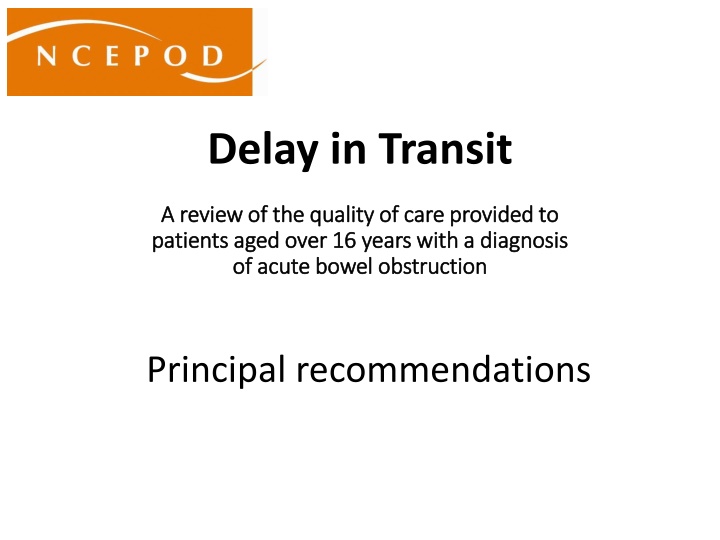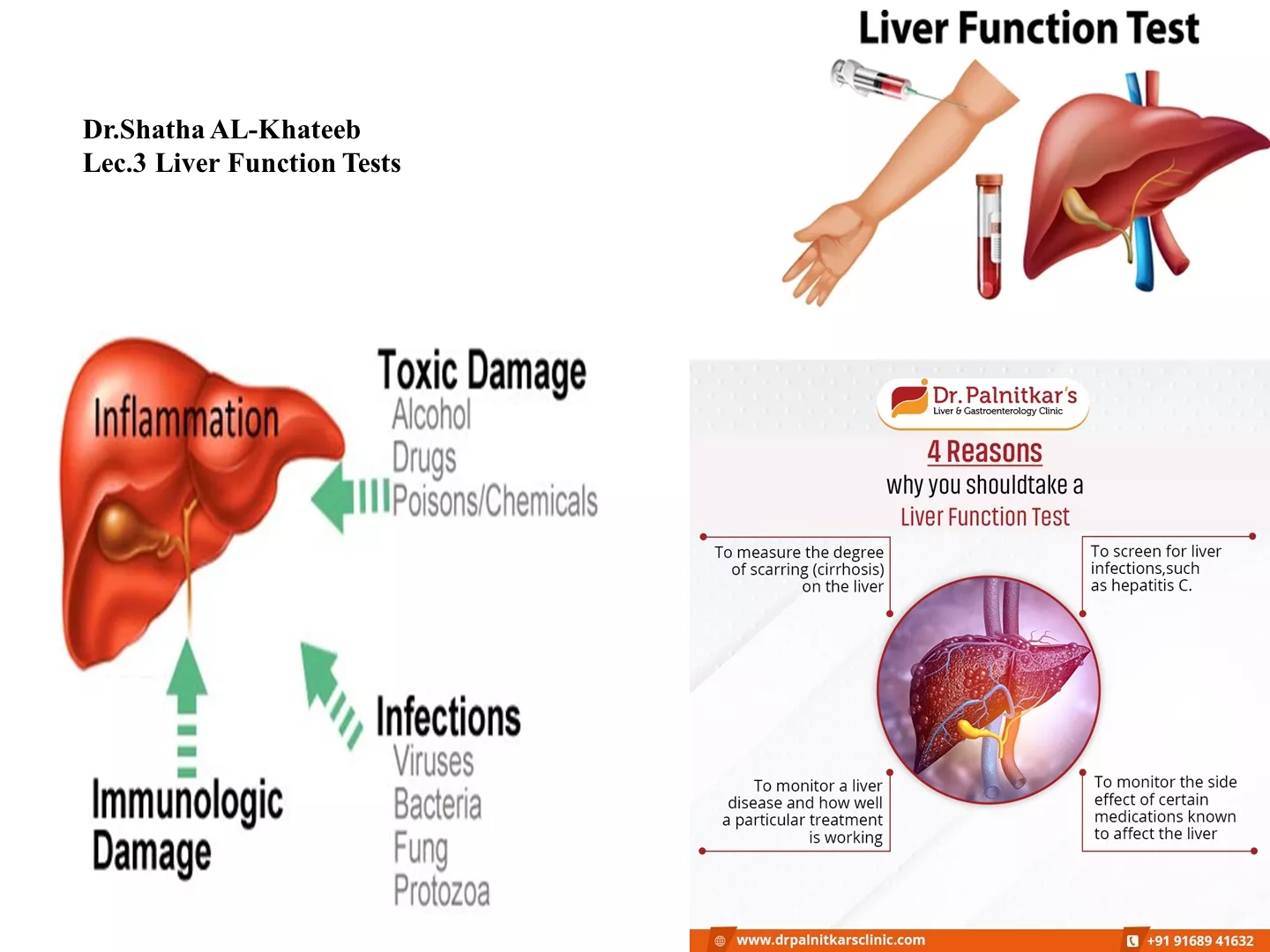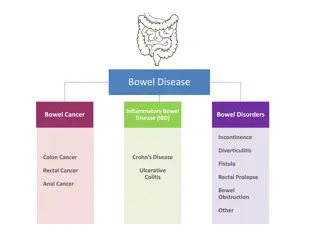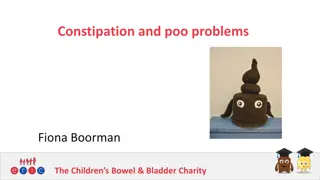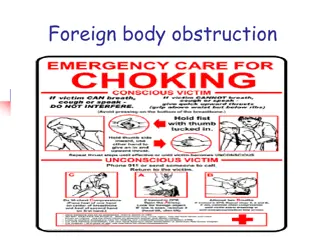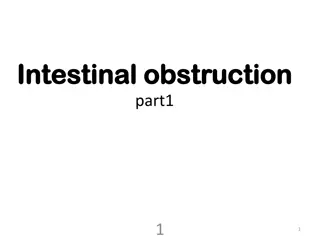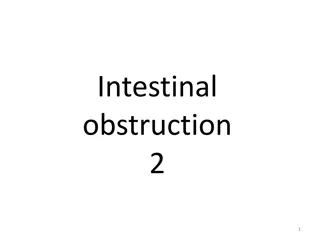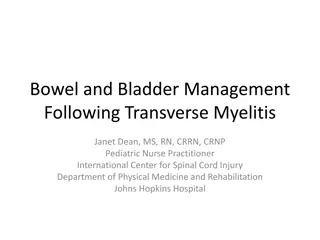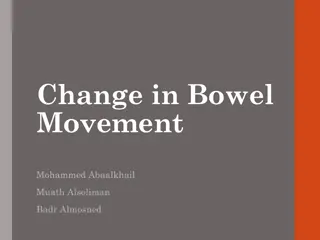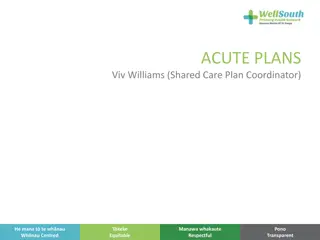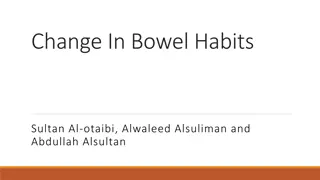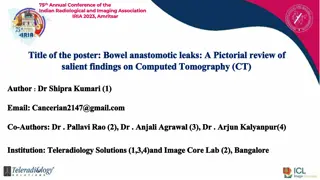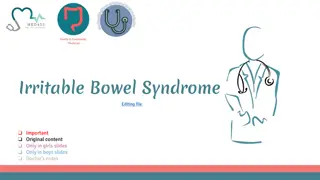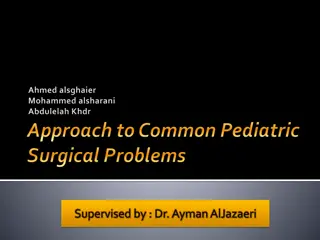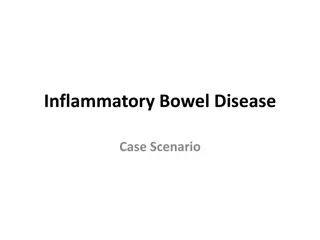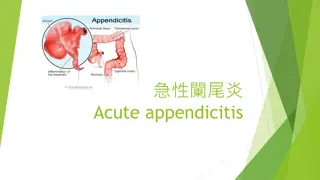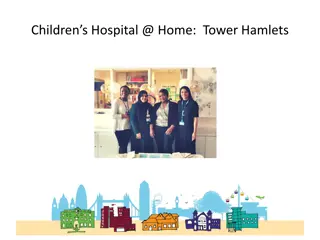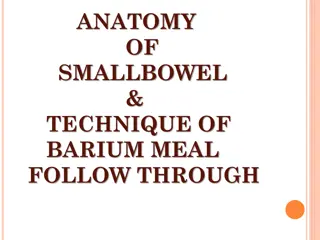Review of Care for Patients with Acute Bowel Obstruction: Recommendations and Key Findings
This review assesses the quality of care provided to patients aged over 16 years with acute bowel obstruction. Significant delays were identified in the care pathway, from imaging requests to availability of operating theatres. Recommendations include prompt CT scans with intravenous contrast for definitive diagnosis. Key findings highlight the efficacy of CT over abdominal X-ray in diagnosing acute bowel obstruction and the benefits of specific care pathways. Improvements are needed in pain management, acute kidney injury (AKI), nutrition, frailty assessment, and surgical risk evaluation.
Download Presentation

Please find below an Image/Link to download the presentation.
The content on the website is provided AS IS for your information and personal use only. It may not be sold, licensed, or shared on other websites without obtaining consent from the author.If you encounter any issues during the download, it is possible that the publisher has removed the file from their server.
You are allowed to download the files provided on this website for personal or commercial use, subject to the condition that they are used lawfully. All files are the property of their respective owners.
The content on the website is provided AS IS for your information and personal use only. It may not be sold, licensed, or shared on other websites without obtaining consent from the author.
E N D
Presentation Transcript
Delay in Transit A review of the quality of care provided to A review of the quality of care provided to patients aged over 16 years with a diagnosis patients aged over 16 years with a diagnosis of acute bowel obstruction of acute bowel obstruction Principal recommendations
The study A review of the quality of care provided to patients aged over 16 years with a diagnosis of acute bowel obstruction Case note review Clinician questionnaire Organisational Questionnaire
Study population Patients aged 18 and older, who had bowel obstruction and were admitted to hospital between 16th April and 13th May 2018. Patients were identified by ICD10 codes for conditions associated with large and small bowel obstruction Sampling of cases/ hospital
Overall assessment of care Figure 10.2 Overall assessment of care
Key messages (1) There were significant delays in the pathway of care for this group of patients, from requesting imaging, diagnosis, decision-making and availability of an operating theatre. There was room for improvement in the assessment/ management of: Pain AKI Nutrition Frailty Risk for surgery
Key messages (2) CT with IV contrast was more useful in making a definitive diagnosis and in influencing decision- making than Abdominal X-Ray There were fewer delays in the pathway for patients who had their care managed using a specific pathway for Acute Bowel Obstruction
Recommendation 1 Undertake a CT scan with intravenous contrast promptly, as the definitive method of imaging* for patients presenting with suspected acute bowel obstruction. Prompt radiological diagnosis will help ensure admission to the correct specialty, so the time to CT reporting should be audited locally. .
Recommendation 1 Key findings There were delays in imaging in 57/276 (20.7%) of the cases reviewed CT with IV contrast was sufficient to diagnose acute bowel obstruction in 427/479 (89.1%) patients whereas abdominal X-ray was sufficient to diagnose acute bowel obstruction in 132/411 (32.1%) CT with IV contrast affected subsequent decision- making in the management of acute bowel obstruction in 456/484 (94.2%) patients and abdominal X-ray in 266/411 (64.7%) patients
Principal recommendation 2 Undertake a consultant review in all patients diagnosed with acute bowel obstruction as soon as clinically indicated and at the latest within 14 hours of admission to hospital. Discussion with a consultant should occur within an hour for high-risk patients*
Recommendation 2 Key Findings 41/258 (15.9%) patients experienced a delay in consultant review 13/32 (40.6%) patients who had a delay in consultant assessment had a delay in diagnosis. Inpatients who were seen in a timely manner by a consultant only 23/147 (15.6%) experienced a delay in diagnosis .
Recommendation 3 Admit patients with symptoms of acute bowel obstruction as necessary, but patients who have a definitive diagnosis of acute bowel obstruction should be admitted under the care of a surgical team.
Recommendation 3 Key findings Delays in obtaining a CT scan with IV contrast were more likely if patients were admitted under the medical team (18/74; 24.3%) compared with admission under surgery (33/351; 9.4%) Clinicians reported a delay in diagnosis that was outside of their control in 22/118 (18.6%) patients where the patient was admitted under medical teams compared with 20/454 (4.4%) of those under surgical teams
Recommendation 3 Key findings (2) A delay in making the decision about the best treatment for the patient occurred in 11/125 (8.8%) admissions under medical teams and 14/483 (2.9%) under surgical teams 14/26 (53.8%) patients who experienced a delay in surgical assessment also had a delay in diagnosis compared with 24/170 (14.1%) when surgical assessment was not delayed
Principal recommendation 4 Assess pain in all patients with symptoms of acute bowel obstruction and give analgesia in line with local and national guidelines. Ensure that: a. Pain is assessed at presentation to the emergency department b. Pain is assessed throughout the admission c. Referral to the acute pain team is undertaken when pain is difficult to manage, while ensuring the referral does not cause a delay in any definitive treatment.
Recommendation 4- Key Findings 438/690 (63.5%) patients had a presenting symptom of pain. However, a pain score was performed in 252/438 (57.5%) of these 163/544 (30.0%) patients did not have their pain score assessed on admission to a ward of which 102/163 (62.6%) patients had presented with abdominal pain 37/639 (5.8%) patients were seen by the acute pain team prior to surgery
Recommendation 5 Measure and document hydration status in all patients presenting with symptoms of acute bowel obstruction in order to minimise the risk of acute kidney injury (AKI). Ensure that hydration status is: a. Assessed at presentation to the emergency department b. Assessed throughout the admission
Recommendation 5 Key findings 163/690 (23.6%) patients had their hydration status recorded and 157/690 (22.8%) patients had their weight recorded resulting in Body Mass Index (BMI) only recorded in 80/690 (11.6%) patients 69/264 (26.1%) patients had acute kidney injury (AKI) on admission and 16 patients developed it following admission. In the view of the case reviewers this was avoidable in four patients and clinicians completing questionnaires thought that AKI resuscitation was inadequate in 10/178 (5.6%) patients
Recommendation 6 Undertake, record and act on nutritional screening in all patients who present with symptoms of acute bowel obstruction. This should include: a. A MUST score on admission to hospital b. A MUST score at least weekly throughout the admission c. Review by a dietitian/nutrition team once a diagnosis has been made d. A MUST score, and if required a dietitian/nutrition team assessment at discharge As recommended by BAPEN
Recommendation 6 Key findings Undertake, record and act on nutritional screening in all patients who present with symptoms of acute bowel obstruction. This should include: a. A MUST score on admission to hospital b. A MUST score at least weekly throughout the admission c. Review by a dietitian/nutrition team once a diagnosis has been made d. A MUST score, and if required a dietitian/nutrition team assessment at discharge As recommended by BAPEN
Recommendation 7 Ensure patients with a high frailty score (eg. Rockwood 5 or more) receive: a. A multidisciplinary team discussion for shared decision-making, including care of the elderly b. A risk assessment, with input from critical care relevant to the patient s needs c. A treatment escalation plan d. Their resuscitation status recorded
Recommendation 7 Key Findings Only 34/124 (27.4%) patients over 65 years of age had their frailty score assessed on admission to the ward 42 Critical care input influenced care in 36/61 (59.0%) patients. Of those patients who had surgery 99/390 (25.4%) required critical care post operatively 579/603 (96.0%) patients had their treatment plan discussed with them and in 394/497 (79.3%) it was discussed with the their family Care of the elderly input was sought in 61/498 (12.2%) patients in the view of the clinicians completing questionnaires. Of the patients who had no care of the elderly input, 343/437 (78.5%) were over the age of 65
Recommendation 8 Ensure local policies are in place for the escalation of patients requiring surgery for acute bowel obstruction to enable rapid access to the operating theatre.* This should be regularly audited to ensure adequate emergency capacity planning. *e.g. The NCEPOD Classification of Intervention can be used to ensure that patients are treated within a clinically acceptable timeframe
Recommendation 8 Key Findings 183/273 (67.0%) patients had their operation within 6 hours of the decision to operate. The inappropriate delay affected the outcome in 8/29 patients where case reviewers found that the timing of surgery was inappropriate 72/368 (19.6%) patients experienced a delay in access to surgery and in 38/72 (52.8%) patients the delay was due to non-availability of theatre, in 34/72(47.2%) it was due non- availability of an anaesthetist and in 15/72 (20.8%) the patient required further treatment 136/170 (80.0%) hospitals had at least one dedicated emergency (CEPOD) theatre #74 120/166 (72.3%) hospitals reported that there was priority grading for emergency surgery and in 79/164 (48.2%) hospitals therewas a theatre co-ordinator to facilitate this
Recommendation 9 Agree joint clinical network pathways of care that enable improved access to stenting services for those patients with acute large bowel obstruction who require the service.
Recommendation 9 Key findings 38/171 (22.2%) hospitals had no on-site access to stenting and only five reported to be part of a clinical network to improve access to this service
Recommendation 10 Calculate morbidity and mortality risk for all patients admitted with, and before any surgery for, acute bowel obstruction, to aid: a. Shared decision-making between the patient, carers and clinicians, with regard to the treatment options available and to ensure the appropriate informed consent is taken b. Assessment of the risk and predicted outcome associated with undertaking a laparotomy
Recommendation 10 Key Findings In 98/219 (44.7%) of patients case reviewers felt that mortality and morbidity risk assessment was not adequate 199/353 (56.4%) patients undergoing emergency surgery for bowel obstruction had their risk of death documented on the consent form 30/109 (27.5%) patients did not have all possible alternative treatment options discussed with them
Recommendation 11 Minimise delays to diagnosis and treatment for acute bowel obstruction. Development of an evidence- based pathway for acute bowel obstruction, including recommendations 1-10 could facilitate this. The pathway should be audited at specific time points such as: a. Time from arrival to CT scan b. Time from arrival to diagnosis c. Time from decision to operate to start of anaesthesia
Recommendation 11 Key Findings Delays in the pathway of care of patients with acute bowel obstruction showing where the same patients were affected by delays at different stages and where different patients were affected28/169 (16.6%) hospitals reported a specific pathway for acute bowel obstruction in 63/169 (37.3%)there was not a specific acute bowel obstruction pathway but a more general acute abdomen pathway Of those hospitals where there was a pathway, they only included guidelines on time limit to treatment decision in 22/91 (24.2%) hospitals and timing of surgery in 33/91 (36.3%) hospitals 149/165 (90.3%) hospitals reported that there was a discharge planning team but in 68/149 (45.6%) hospitals this did not include nutrition or dietetic staff
Discussion Is there a dedicated pathway in place for the identification and management / care of patients with ABO? Does the pathway include time to CT contrast? Is it audited? Are patients with ABO admitted under surgeons? Is there a system in place to ensure that patients with ABO are assessed for hydration/ nutrition / frailty needs and for pain management requirements Is there a robust system in place assess the risk of surgery for acutely admitted patients? And to prioritise emergency surgery
Delay in Transit Delay in Transit Full report, summary and implementation tools are be found at www.ncepod.org.uk/2020abo.html
